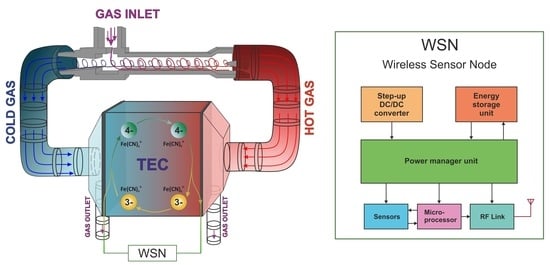Power Supply of Wireless Sensors Based on Energy Conversion of Separated Gas Flows by Thermoelectrochemical Cells
Abstract
1. Introduction
2. Components Review
2.1. Ranque–Hilsch Vortex Tube
2.2. Temperature Gradient Conversion
- No moving parts or working fluids inside the TEG;
- Long service life, especially with permanent heat sources;
- No economies of scale: TEG can be used for micro-generation in a very limited space or for generating huge amounts of energy;
- Silent operation;
- Any operating position is possible, which makes TEGs suitable for embedded systems [20].
2.3. Design and Characteristics of Energy Converter
2.4. DC/DC Boost Converter
3. Designed and Simulation of Power Supply System
3.1. Block Diagram of a Power Supply System for Wireless Sensor Node
3.2. Simulation
4. Conclusions
Author Contributions
Funding
Conflicts of Interest
References
- Volkov, A.A.; Sukneva, L.V. BIM-technology in tasks of the designing complex systems of alternative energy supply. Procedia Eng. 2014, 91, 377–380. [Google Scholar] [CrossRef][Green Version]
- Kodirov, D.; Muratov, K.; Tursunov, O.; Ugwu, E.I.; Durmanov, A. The use of renewable energy sources in integrated energy supply systems for agriculture. IOP Conf. Ser. Earth Environ. Sci. 2020, 614, 012007. [Google Scholar] [CrossRef]
- Inaudi, D.; Glisic, B. Reliability and field testing of distributed strain and temperature sensors. In Proceedings of the Smart Structures and Materials 2006: Smart Sensor Monitoring Systems and Applications, San Diego, CA, USA, 30 March 2006; Volume 6167, p. 61671D. [Google Scholar]
- Ukil, A.; Braendle, H.; Krippner, P. Distributed temperature sensing: Review of technology and applications. IEEE Sens. J. 2011, 12, 885–892. [Google Scholar] [CrossRef]
- Feng, X.; Han, Y.; Wang, Z.; Liu, H. Structural performance monitoring of buried pipelines using distributed fiber optic sensors. J. Civ. Struct. Health Monit. 2018, 8, 509–516. [Google Scholar] [CrossRef]
- Junie, P.; Dinu, O.; Eremia, C.; Stefanoiu, D.; Petrescu, C.; Savulescu, I. A WSN based monitoring system for oil and gas transportation through pipelines. IFAC Proc. Vol. 2012, 45, 1796–1801. [Google Scholar] [CrossRef]
- Mahdal, M.; Wagnerová, R.; Frischer, R. Alternative methods of power supply for autonomous intelligent wireless sensors. In Proceedings of the 2011 12th International Carpathian Control Conference (ICCC), Velke Karlovice, Czech Republic, 25–28 May 2011; pp. 258–261. [Google Scholar]
- Prauzek, M.; Konecny, J.; Borova, M.; Janosova, K.; Hlavica, J.; Musilek, P. Energy Harvesting Sources, Storage Devices and System Topologies for Environmental Wireless Sensor Networks: A Review. Sensors 2018, 18, 2446. [Google Scholar] [CrossRef]
- Antony, S.M.; Indu, S.; Pandey, R. An efficient solar energy harvesting system for wireless sensor network nodes. J. Inf. Optim. Sci. 2020, 41, 39–50. [Google Scholar] [CrossRef]
- Grossi, M. Energy Harvesting Strategies for Wireless Sensor Networks and Mobile Devices: A Review. Electronics 2021, 10, 661. [Google Scholar] [CrossRef]
- Deng, F.; Yue, X.; Fan, X.; Guan, S.; Xu, Y.; Chen, J. Multisource Energy Harvesting System for a Wireless Sensor Network Node in the Field Environment. IEEE Internet Things J. 2019, 6, 918–927. [Google Scholar] [CrossRef]
- Qi, N.; Yin, Y.; Dai, K.; Wu, C.; Wang, X.; You, Z. Comprehensive optimized hybrid energy storage system for long-life solar-powered wireless sensor network nodes. Appl. Energy 2021, 290, 116780. [Google Scholar] [CrossRef]
- Liu, Y.; Wang, H.; Sherrell, P.C.; Liu, L.; Wang, Y.; Chen, J. Potentially Wearable Thermo-Electrochemical Cells for Body Heat Harvesting: From Mechanism, Materials, Strategies to Applications. Adv. Sci. 2021, 8, 2100669. [Google Scholar] [CrossRef]
- Nimbalkar, S.U.; Muller, M.R. An experimental investigation of the optimum geometry for the cold end orifice of a vortex tube. Appl. Therm. Eng. 2009, 29, 509–514. [Google Scholar] [CrossRef]
- Behera, U.; Paul, P.J.; Dinesh, K.; Jacob, S. Numerical investigations on flow behaviour and energy separation in Ranque–Hilsch vortex tube. Int. J. Heat Mass Transf. 2008, 51, 6077–6089. [Google Scholar] [CrossRef]
- Hamdan, M.O.; Al-Omari, S.A.; Oweimer, A.S. Experimental study of vortex tube energy separation under different tube design. Exp. Therm. Fluid Sci. 2018, 91, 306–311. [Google Scholar] [CrossRef]
- Twaha, S.; Zhu, J.; Yan, Y.; Li, B. A comprehensive review of thermoelectric technology: Materials, applications, modelling and performance improvement. Renew. Sustain. Energy Rev. 2016, 65, 698–726. [Google Scholar] [CrossRef]
- Riffat, S.B.; Ma, X. Thermoelectrics: A review of present and potential applications. Appl. Therm. Eng. 2003, 23, 913–935. [Google Scholar] [CrossRef]
- Mamur, H.; Ahiska, R. A review: Thermoelectric generators in renewable energy. Int. J. Renew. Energy Res. 2014, 4, 128–136. [Google Scholar]
- Champier, D. Thermoelectric generators: A review of applications. Energy Convers. Manag. 2017, 140, 167–181. [Google Scholar] [CrossRef]
- Montecucco, A.; Siviter, J.; Knox, A.R. The effect of temperature mismatch on thermoelectric generators electrically connected in series and parallel. Appl. Energy 2014, 123, 47–54. [Google Scholar] [CrossRef]
- Dupont, M.F.; MacFarlane, D.R.; Pringle, J.M. Thermo-electrochemical cells for waste heat harvesting–progress and perspectives. Chem. Commun. 2017, 53, 6288–6302. [Google Scholar] [CrossRef]
- Im, H.; Kim, T.; Song, H.; Choi, J.; Park, J.S.; Ovalle-Robles, R.; Yang, H.D.; Kihm, K.D.; Baughman, R.H.; Lee, H.H.; et al. High-efficiency electrochemical thermal energy harvester using carbon nanotube aerogel sheet electrodes. Nat. Commun. 2016, 7, 10600. [Google Scholar] [CrossRef]
- Artyukhov, D.; Kiselev, N.; Gorshkov, N.; Kovyneva, N.; Ganzha, O.; Vikulova, M.; Gorokhovsky, A.; Offor, P.; Boychenko, E.; Burmistrov, I. Harvesting Waste Thermal Energy Using a Surface-Modified Carbon Fiber-Based Thermo-Electrochemical Cell. Sustainability 2021, 13, 1377. [Google Scholar] [CrossRef]
- Bonetti, M.; Nakamae, S.; Huang, B.T.; Salez, T.J.; Wiertel-Gasquet, C.; Roger, M. Thermoelectric energy recovery at ionic-liquid/electrode interface. J. Chem. Phys. 2015, 142, 244708. [Google Scholar] [CrossRef]
- Bonetti, M.; Nakamae, S.; Roger, M.; Guenoun, P. Huge Seebeck coefficients in nonaqueous electrolytes. J. Chem. Phys. 2011, 134, 114513. [Google Scholar] [CrossRef]
- Artyukhov, D.; Kiselev, N.; Gorshkov, N.; Burmistrov, I. Research of the influence of electrolyte concentration on thermo-electrochemical cells efficiency. Proc. Environ. Sci. Eng. Manag. 2019, 6, 319–327. [Google Scholar]
- Hu, R.; Cola, B.A.; Haram, N.; Barisci, J.N.; Lee, S.; Stoughton, S.; Wallace, G.; Too, C.; Thomas, M.; Gestos, A. Harvesting waste thermal energy using a carbon-nanotube-based thermo-electrochemical cell. Nano Lett. 2010, 10, 838–846. [Google Scholar] [CrossRef]
- Duan, J.; Feng, G.; Yu, B.; Li, J.; Chen, M.; Yang, P.; Feng, J.; Liu, K.; Zhou, J. Aqueous thermogalvanic cells with a high Seebeck coefficient for low-grade heat harvest. Nat. Commun. 2018, 9, 5146. [Google Scholar] [CrossRef]
- Kim, J.H.; Kang, T.J. Diffusion and Current Generation in Porous Electrodes for Thermo-electrochemical Cells. ACS Appl. Mater. Interfaces 2019, 11, 28894–28899. [Google Scholar] [CrossRef]
- Burmistrov, I.; Gorshkov, N.; Kovyneva, N.; Kolesnikov, E.; Khaidarov, B.; Karunakaran, G.; Cho, E.-B.; Kiselev, N.; Artyukhov, D.; Kuznetsov, D.; et al. High seebeck coefficient thermo-electrochemical cell using nickel hollow microspheres electrodes. Renew. Energy 2020, 157, 1–8. [Google Scholar] [CrossRef]
- Kim, T.; Lee, J.S.; Lee, G.; Yoon, H.; Yoon, J.; Kang, T.J.; Kim, Y.H. High thermopower of ferri/ferrocyanide redox couple in organic-water solutions. Nano Energy 2017, 31, 160–167. [Google Scholar] [CrossRef]
- Yang, H.D.; Tufa, L.T.; Bae, K.M.; Kang, T.J. A tubing shaped, flexible thermal energy harvester based on a carbon nanotube sheet electrode. Carbon 2015, 86, 118–123. [Google Scholar] [CrossRef]
- Zhou, H.; Liu, P. High Seebeck coefficient electrochemical thermocells for efficient waste heat recovery. ACS Appl. Energy Mater. 2018, 1, 1424–1428. [Google Scholar] [CrossRef]
- Richelli, A.; Colalongo, L.; Tonoli, S.; Kovacs-Vajna, Z.M. A 0.2–1.2V DC/DC boost converter for power harvesting applications. IEEE Trans. Power Electron. 2009, 24, 1541–1546. [Google Scholar] [CrossRef]
- Carlson, E.; Strunz, K.; Otis, B. 20 mV input boost converter for thermoelectric energy harvesting. In Proceedings of the 2009 Symposium on VLSI Circuits, Kyoto, Japan, 16–18 June 2009; pp. 162–163. [Google Scholar]
- Yu, H.; Wu, H.; Wen, Y.; Ping, L. An ultra-low input voltage DC-DC boost converter for micro-energy harvesting system. In Proceedings of the 2nd International Conference on Information Science and Engineering, Hangzhou, China, 4–6 December 2010; pp. 86–89. [Google Scholar]
- Gruber, J.M.; Mathis, S. P3.6-Efficient Boost Converter for Thermoelectric Energy Harvesting. Proc. Sens. 2017, 2017, 642–645. [Google Scholar]
- Dillersberger, H.; Deutschmann, B.; Tham, D. A bipolar ± 13 mV self-starting and 85% peak efficiency DC/DC converter for thermoelectric energy harvesting. Energies 2020, 13, 5501. [Google Scholar] [CrossRef]
- Ultralow Voltage Step-Up Converter and Power Manager LTC3108. Available online: http://www.linear.com/LTC3108 (accessed on 21 December 2021).
- Artyukhov, D.; Burmistrov, I.; Artyukhov, I. Electric Power Supply of Wireless Sensors by Thermo-Electrochemical Cells. In Proceedings of the 2019 16th Conference on Electrical Machines, Drives and Power Systems (ELMA), Varna, Bulgaria, 6–8 June 2019; pp. 1–5. [Google Scholar]
- Coupled Inductors LPR6235. Available online: http://www.coilcraft.com (accessed on 21 December 2021).
- Lokere, K. Wireless Precision Temperature Sensor Powers Itself, Forms Own Network, Enabling Easy Deployment in Industrial Environments. LT J. Analog. Innov. 2014, 24, 26–31. [Google Scholar]
- Wang, W.; Cionca, V.; Wang, N.; Hayes, M.; O’flynn, B.; O’mathuna, C. Thermoelectric energy harvesting for building energy management wireless sensor networks. Int. J. Distrib. Sens. Netw. 2013, 9, 232438. [Google Scholar] [CrossRef]

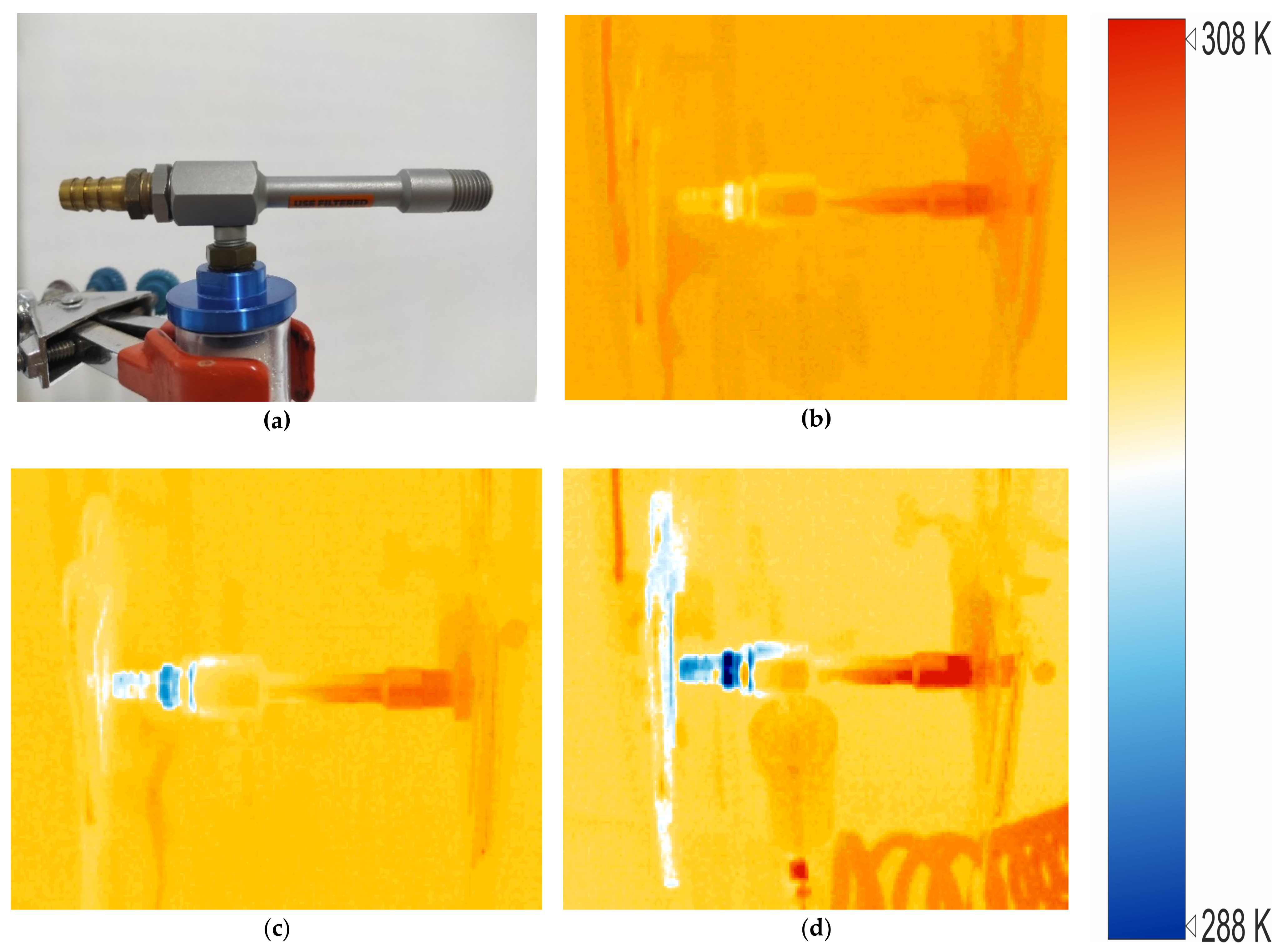
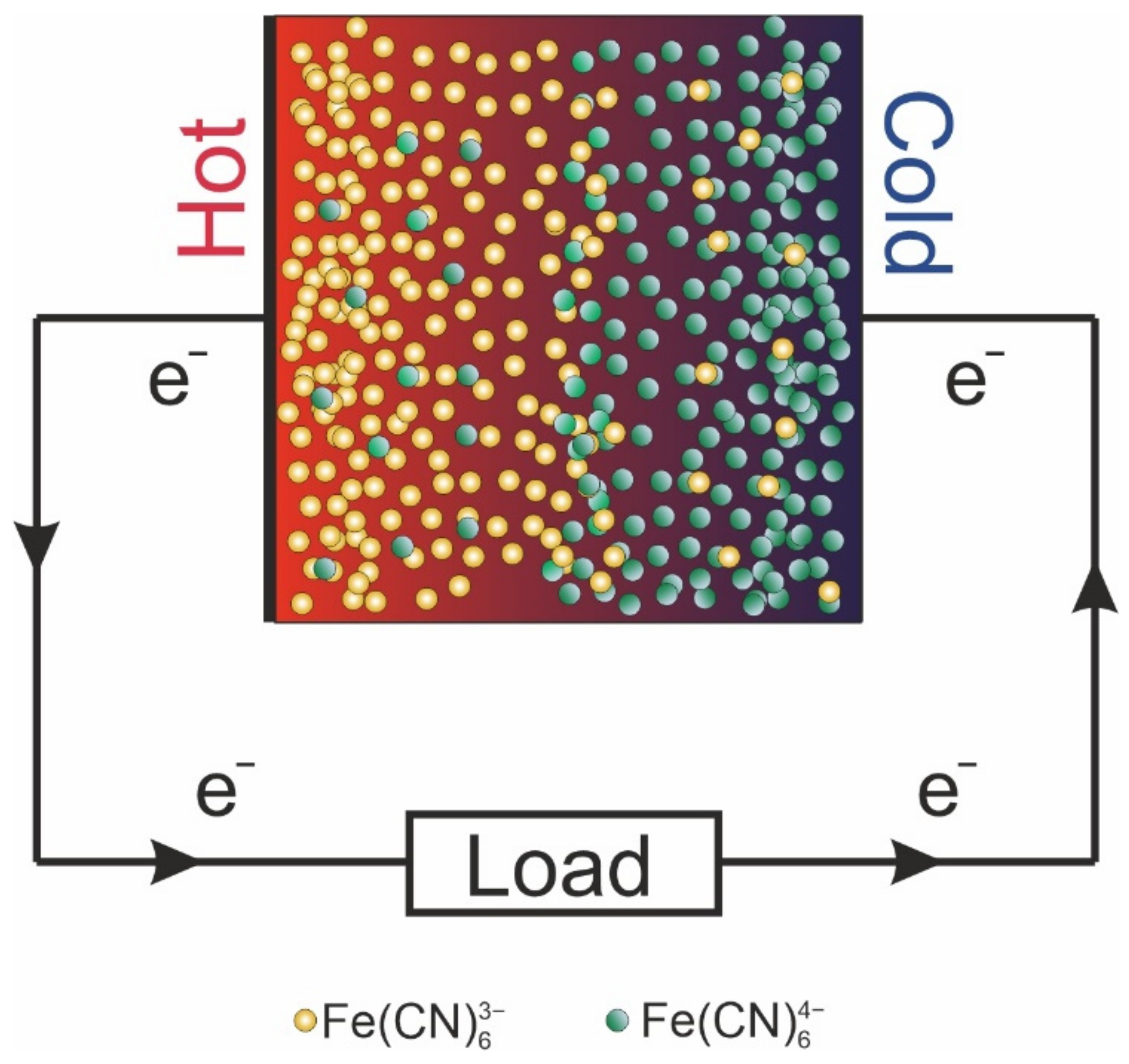
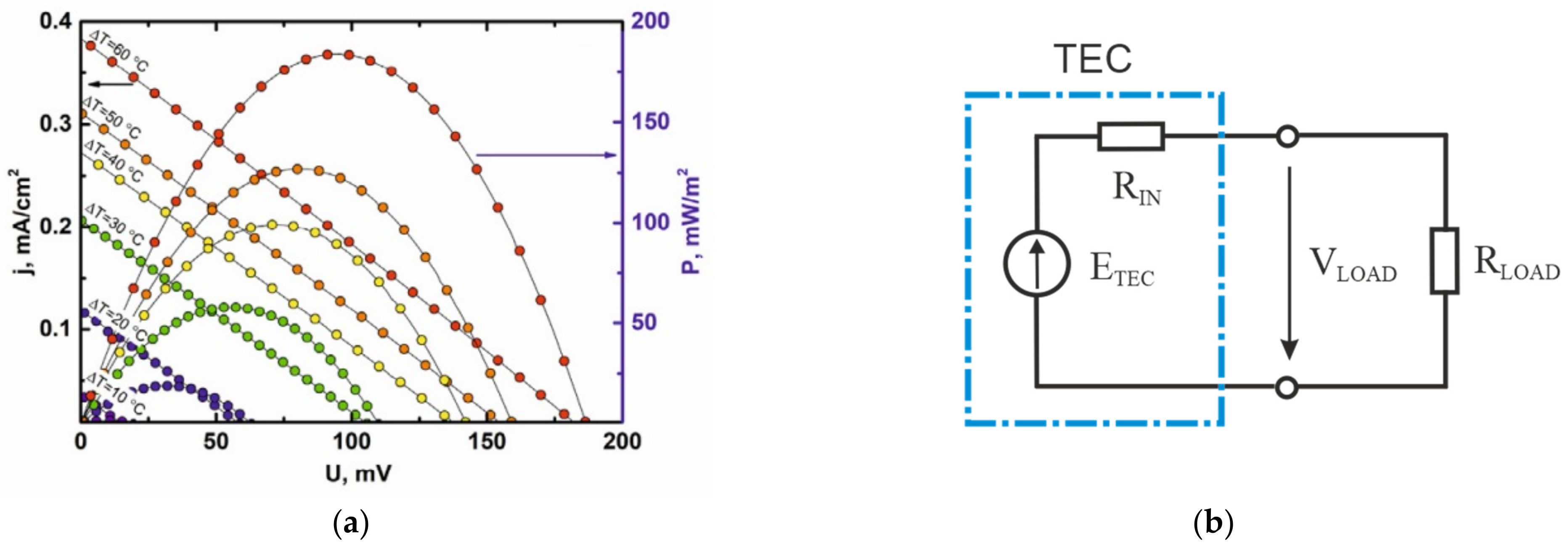

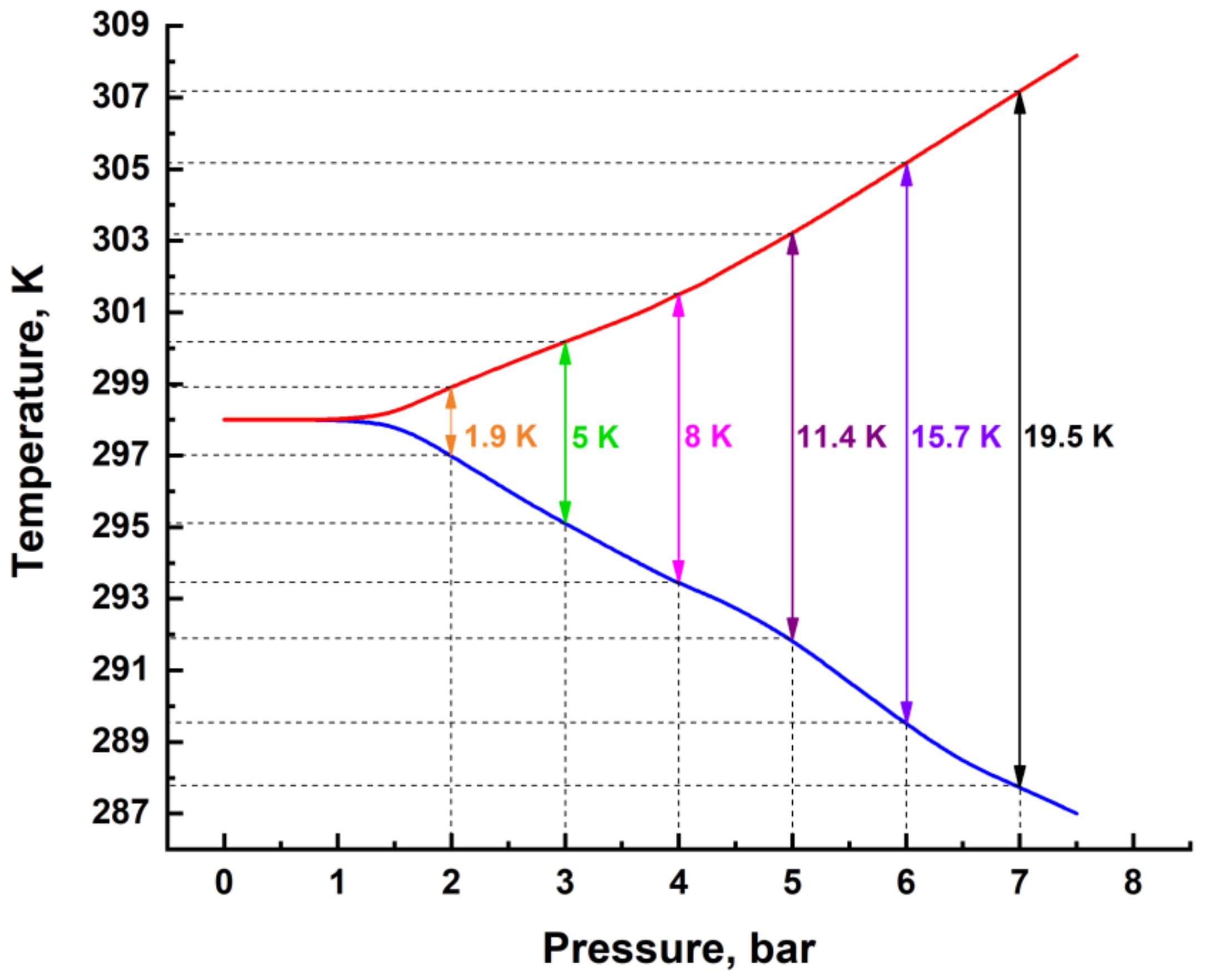
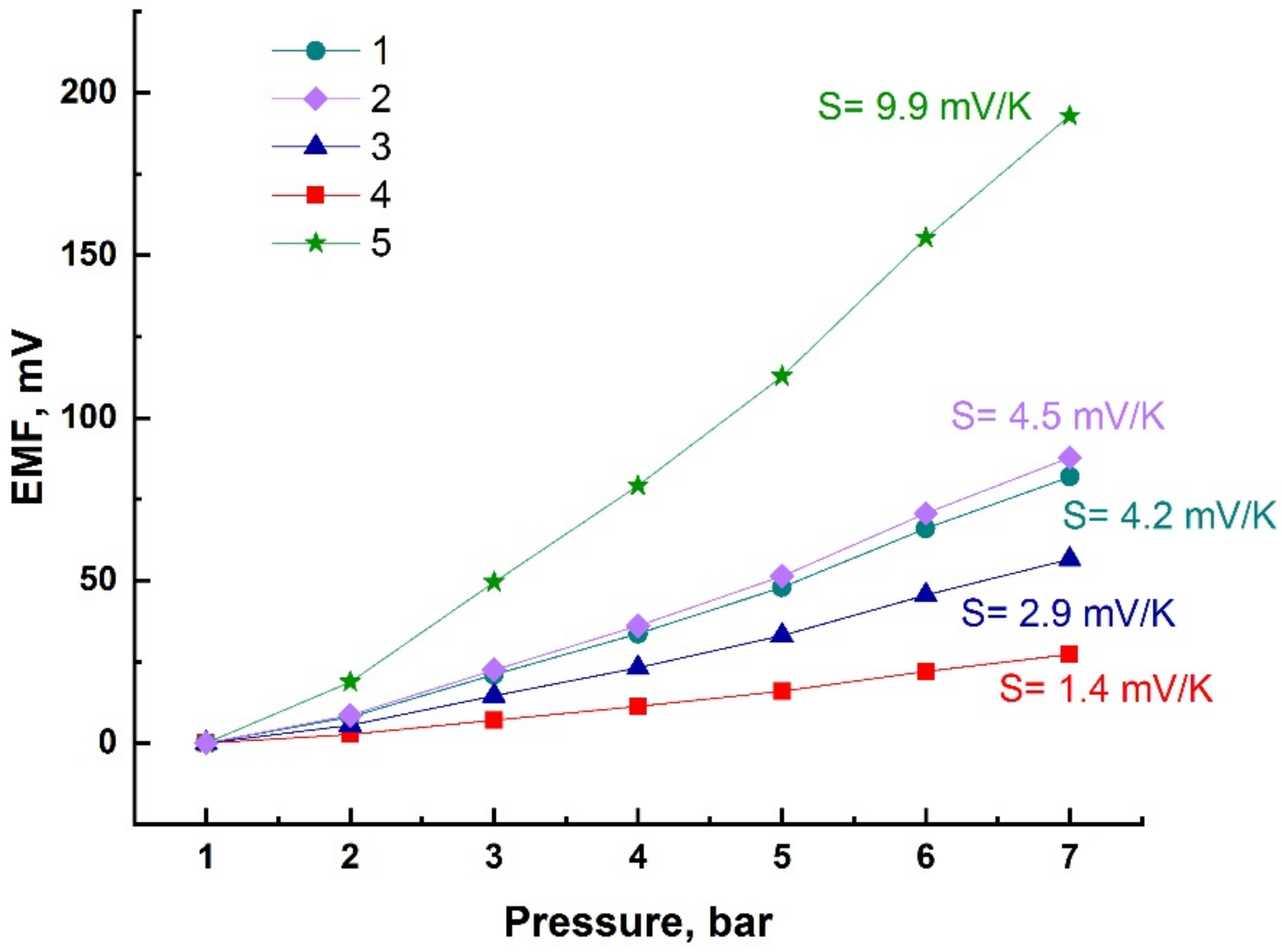

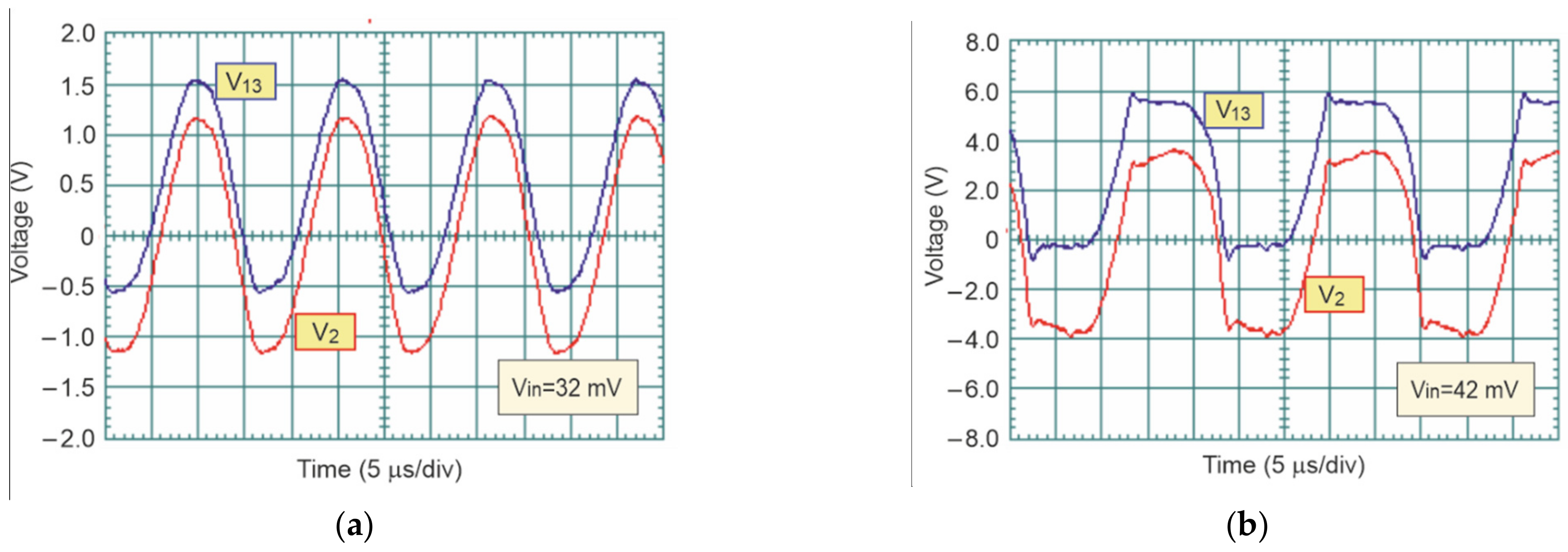
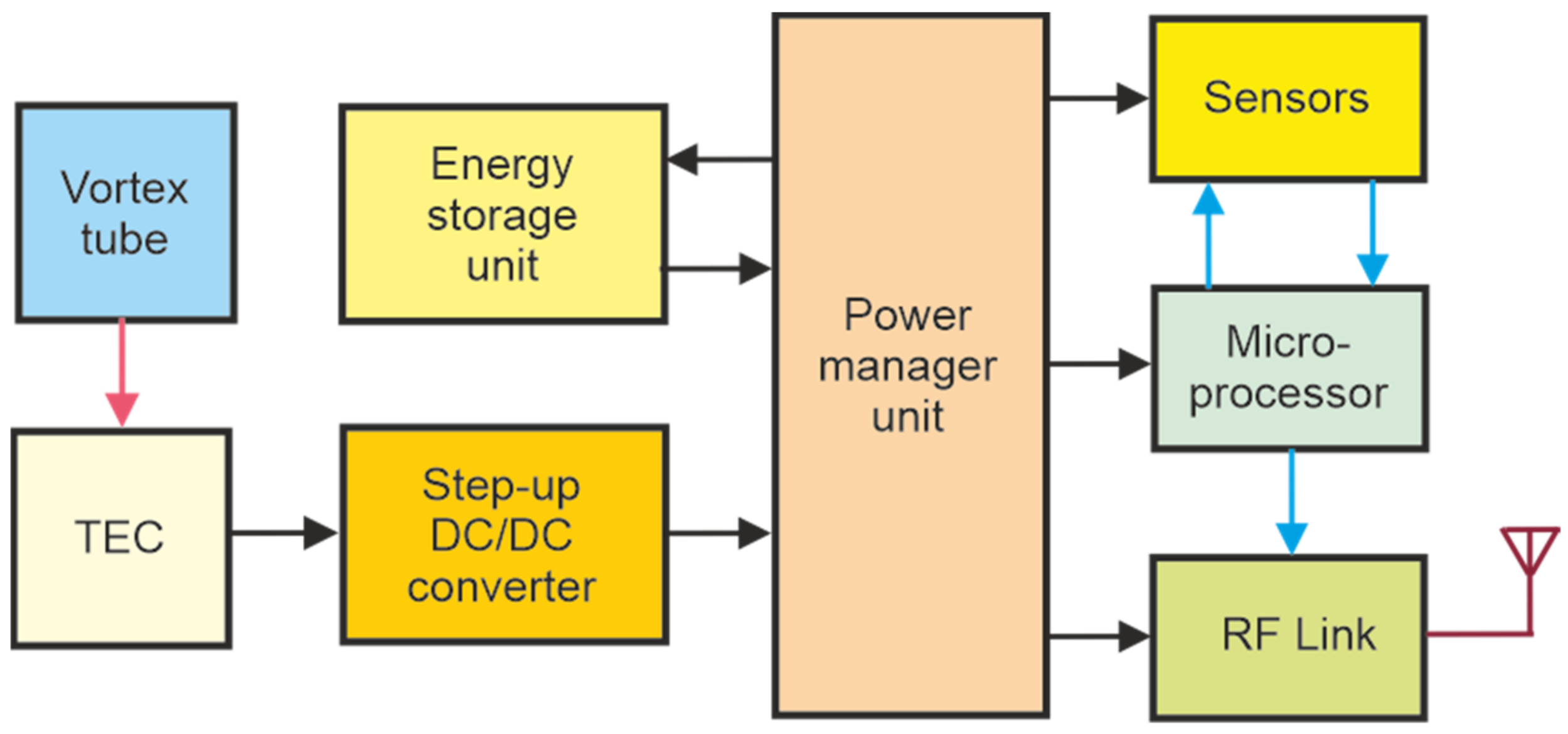
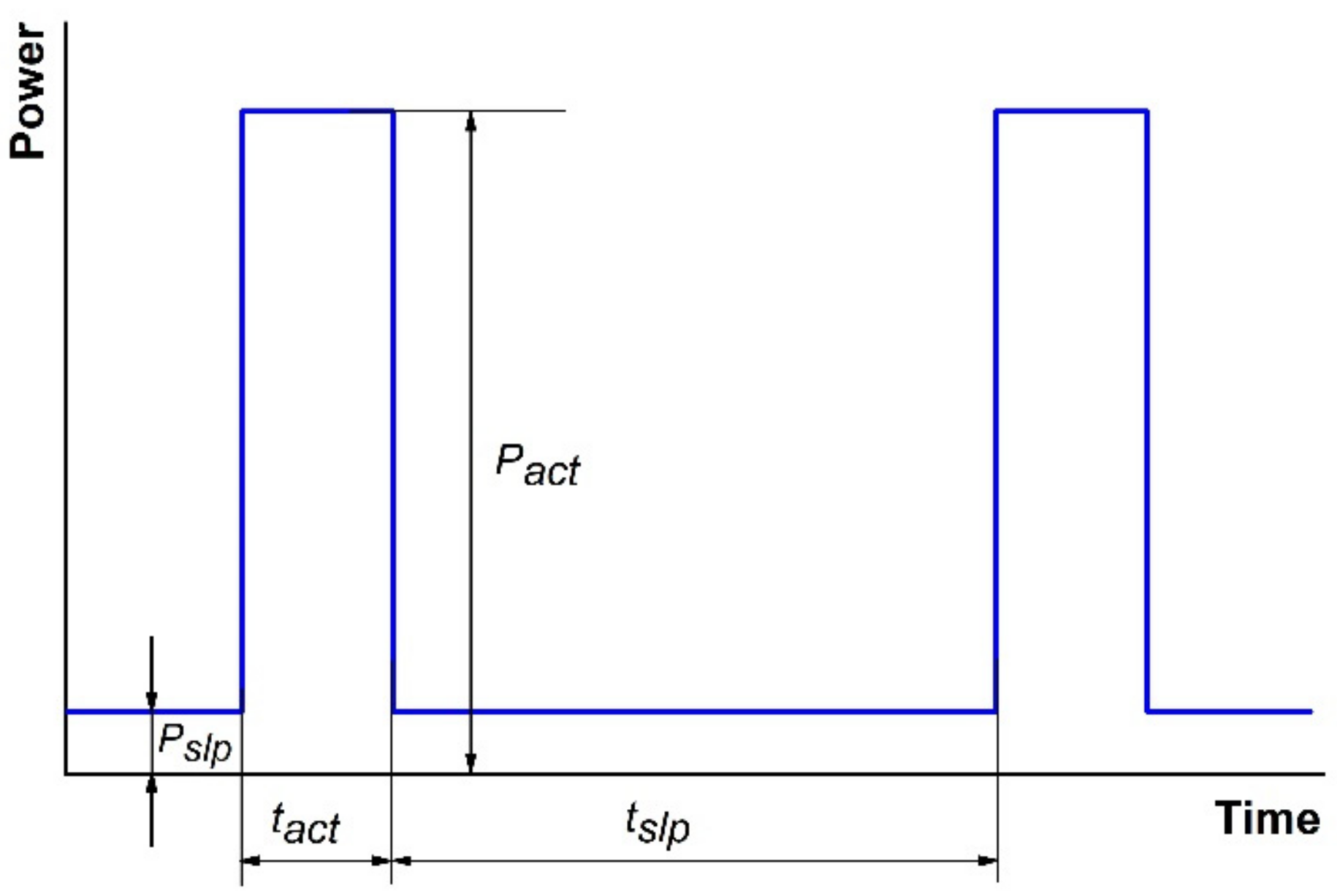
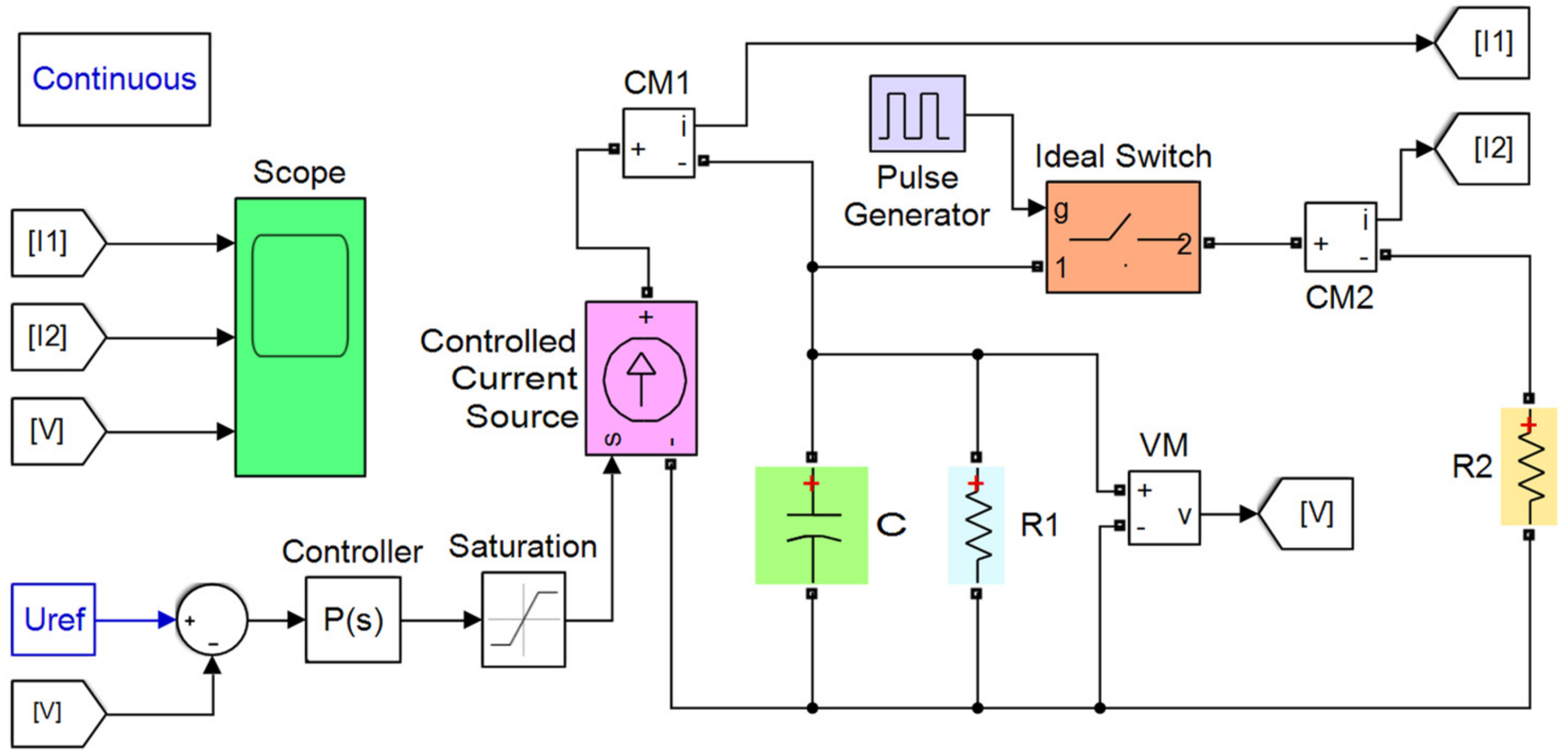

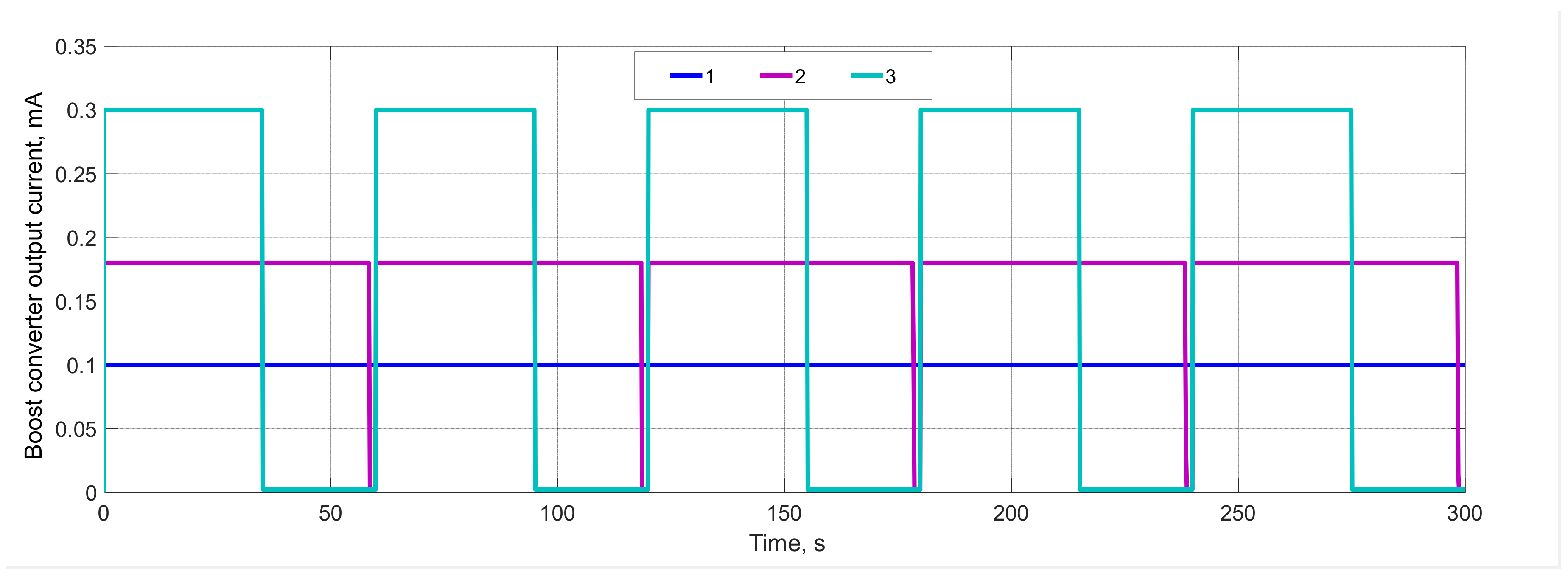

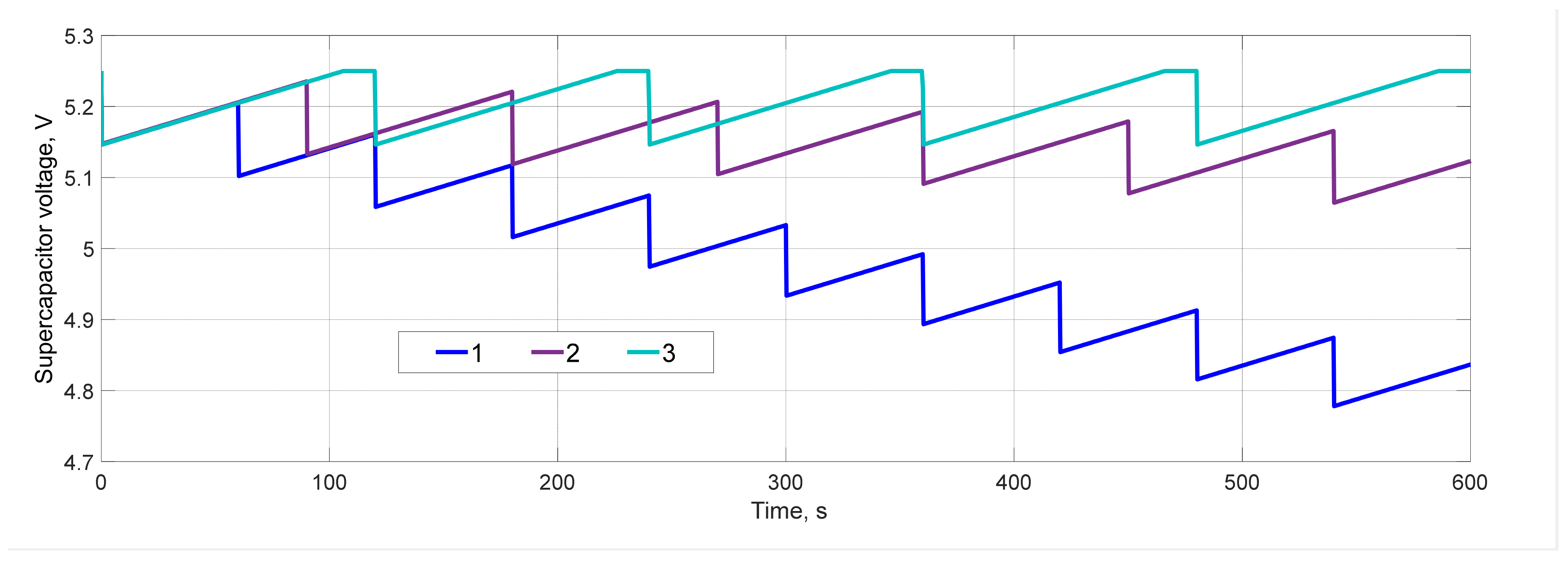
Publisher’s Note: MDPI stays neutral with regard to jurisdictional claims in published maps and institutional affiliations. |
© 2022 by the authors. Licensee MDPI, Basel, Switzerland. This article is an open access article distributed under the terms and conditions of the Creative Commons Attribution (CC BY) license (https://creativecommons.org/licenses/by/4.0/).
Share and Cite
Artyukhov, D.; Gorshkov, N.; Vikulova, M.; Kiselev, N.; Zemtsov, A.; Artyukhov, I. Power Supply of Wireless Sensors Based on Energy Conversion of Separated Gas Flows by Thermoelectrochemical Cells. Energies 2022, 15, 1256. https://doi.org/10.3390/en15041256
Artyukhov D, Gorshkov N, Vikulova M, Kiselev N, Zemtsov A, Artyukhov I. Power Supply of Wireless Sensors Based on Energy Conversion of Separated Gas Flows by Thermoelectrochemical Cells. Energies. 2022; 15(4):1256. https://doi.org/10.3390/en15041256
Chicago/Turabian StyleArtyukhov, Denis, Nikolay Gorshkov, Maria Vikulova, Nikolay Kiselev, Artem Zemtsov, and Ivan Artyukhov. 2022. "Power Supply of Wireless Sensors Based on Energy Conversion of Separated Gas Flows by Thermoelectrochemical Cells" Energies 15, no. 4: 1256. https://doi.org/10.3390/en15041256
APA StyleArtyukhov, D., Gorshkov, N., Vikulova, M., Kiselev, N., Zemtsov, A., & Artyukhov, I. (2022). Power Supply of Wireless Sensors Based on Energy Conversion of Separated Gas Flows by Thermoelectrochemical Cells. Energies, 15(4), 1256. https://doi.org/10.3390/en15041256










